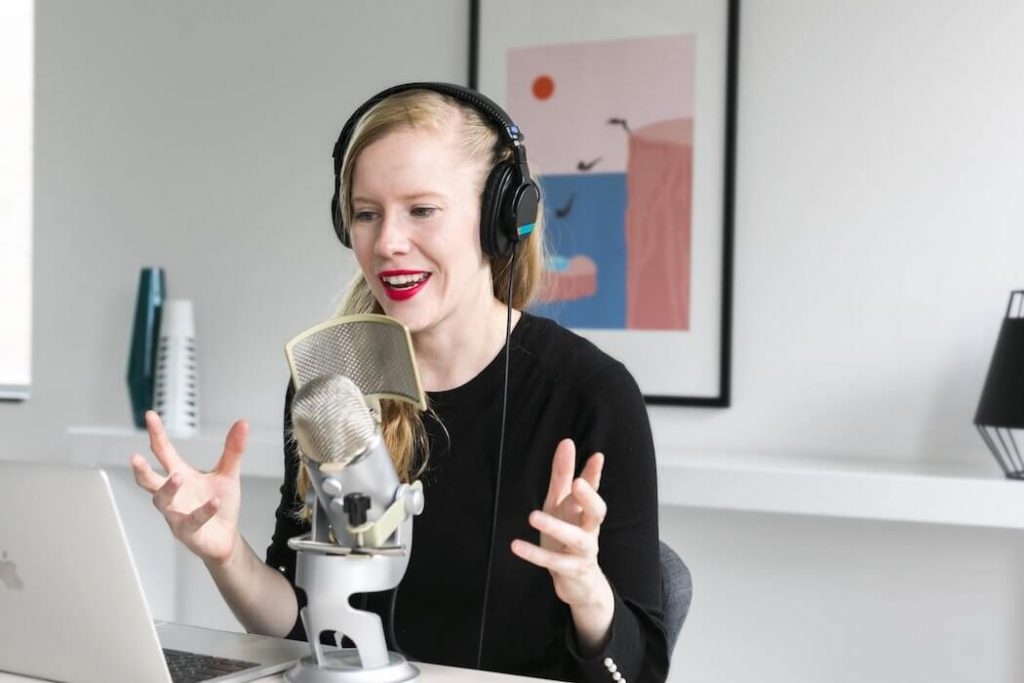Since the 1920s, companies have sponsored various types of media to indirectly market their products or services, from newspapers to radio to TV and, more recently, a myriad of forms of social media. Now, we’re seeing the rise of podcasting, a brand new landscape for brand-driven storytelling.
Podcasting has become one of the best ways to reach a global audience.
Even better, the time and resources needed to take advantage of this media format are nominal in comparison to more expensive and complex options like promotional videos or TV segments. Really, all you need for a successful podcast is a microphone, a voice, and some great ideas and stories.
As the name suggests, branded podcasts are podcasts created by, or in collaboration with, brands, and this interesting form of content marketing has been rapidly gaining popularity. So it’s no wonder that founders are jumping on the podcast train. But with over 800,000 active podcasts and 3,000 new shows popping up every week, breaking through can be an uphill battle. For founders willing to go the distance, however, the rewards can be incredible.
RELATED: The best employer branding is a magnet and a filter
Podcasting has become one of the best ways to reach a global audience, create an intimate connection with your listeners, and provide valuable on-demand content – and for free! So if you are a founder looking to build better brand trust and engagement with your customers, and reap the benefits of high conversion rates, below are some tips on breaking through the noise and putting your podcast on the map.
1. Be the first, the best, or just different
If you haven’t started your podcast yet, the first thing you need to do before moving forward is to research ideas for your show. While no topic is too niche for podcasting, you should at least ensure that there is some demand or natural community for the content you want to make.
See what’s available out there on the market right now. Are there any podcasts covering the same topic? Spoiler alert: there probably are. But are they approaching it from the same angle you intend to and talking about the same things? No? Great. But don’t discount them yet; these are going to be your direct competitors in the struggle to attract and retain listeners. You’ll want to keep a close eye on them.

Conversely, if you can’t find any podcasts even remotely similar to your show idea, you may want to consider why. Is it truly because no one has thought of the idea before, or is it because there isn’t an audience for the content? More likely than not, you’re not going to be the first in the market but you need to make sure your podcast has a hook or unique selling point.
2. Cover art matters
While it’s imperative that your content is unique, your cover art matters too. It needs to be able to stand out amongst the myriad of other shows out there. While the very nature of podcasting is overwhelmingly auditory, don’t neglect the visual element. Make sure that when potential listeners search for a relevant topic, the artwork for your podcast catches their eye. Getting attention is half the battle.
3. Bring on unique guests
Don’t be afraid to bring unique guests onto your show. One of the cliché strategies you’ll often see with new podcasts is an interview with ‘insert-famous-industry-name-here’, a.k.a that big shot who’s an expert within your chosen topic. So what’s the problem with this strategy?
Think creatively and try to find people who haven’t been interviewed before, individuals who can truly provide unique insights.
Go back and reread step one. Your target podcast listener has been there, heard that. Your big-name person has probably already appeared on many other competitors’ shows before, and probably even been asked the same questions. Why? For the same reasons you want to interview them. It’s obvious. It’s easy. And, frankly, it’s boring and repetitive.
Think creatively and try to find people who haven’t been interviewed before, individuals who can truly provide unique insights. You get bonus points if those people themselves already have a large following. Alternatively, if you really can’t avoid bringing on people who have already been covered extensively, try to make sure you’re at least talking about something new so that you’re adding something different to the conversation.
4. Create a trailer
If you haven’t already, one simple thing you can do is create a trailer for your podcast. Whether you’ve published a grand total of zero, or over 150 episodes, trailers are a fantastic opportunity to draw in new listeners. With Apple Podcasts, for example, trailers are ‘pinned’ to the top of podcast feeds so if you have one, it will always show up first. Making use of this feature is a great way to capture new audiences.
But be smart with your trailer. Think of it like a first impression. People are also busy, so you need to make it easy for them to get a feel for your podcast with a 30-second to three-minute teaser. A trailer is also a great marketing tool. Instead of asking someone to head to a website homepage or to subscribe on their podcast app, linking a trailer is an easy, low-risk, low-time-investment option.
5. SEO, ranking, and keywords
The most common way people find new podcasts is still word of mouth, but, many listeners still use search engines to find shows.
In the past, this manifested in the form of numbered lists titled something like ‘Best of XXX’ or ‘Top 10 Podcasts on XXX’, so if you could get your show featured on one of those, you were golden. But this strategy is changing.

Last May, Google announced plans to index podcasts based on their metadata, including the title of the show or individual episodes, as well as other components like show notes and audio. In addition, much like Youtube videos, you can now play podcasts directly from Google search results. This means that your search ranking is more important than ever.
One important way to enhance your SEO (i.e. how easy it is to find your show in searches) is to make sure the title of your episodes includes at least one keyword. Basically, you want your show to pop up in the results when listeners search for this particular keyword. Try using a free online tool like Ubsersuggest to see which keywords have a high search volume but low result yield (i.e. haven’t already been used by your direct competitors).
6. Make use of analytics
Using built-in analytics tools – such as the analytics feature in Apple Podcast or episode performance in Spotify – gives you a wealth of valuable information by allowing you to see exactly how listeners are responding to your episodes.
These tools automatically compile various metrics and graphs which indicate how much time and attention listeners are giving to your podcast. You can also use them to do a deep dive and look at audience retention throughout a particular episode, showing you exactly the moment, down to the very second, where listeners skip ahead or stop listening.

It’s important to bear some drawbacks in mind. For example, while Apple Podcast Analytics is an incredibly useful tool to help you understand how people are consuming your podcast, it only compiles data on one segment of your total audience. Despite being the most popular listening app, Apple Podcasts is only responsible for around 58 percent of global podcast downloads.
The same goes for analytics tools from other apps,they will only capture part of the whole picture. Also, be aware that you need to have produced at least 10 episodes to get sufficient data points for comparison purposes. After that, you’ll be able to start comparing analytics from different episodes and drawing insights to inform future content.
7. Market your show
There are hundreds, if not thousands, of different marketing techniques you can use to advertise your podcast.
For example, getting featured as a guest on other shows is a good way to promote your podcast. Look for podcasts with content which would resonate with your target listeners and reach out to the hosts directly. You can also check out Radio Guest List, an online platform which connects talkshow, radio, and podcast hosts with guest speakers.
RELATED: Why 2019 will reveal Canada’s new tech darling (CanCon ep. 139)
Another option to extend your reach is live video streaming. Live segments offer an increased opportunity for audience engagement and are a great way of building a relationship with your listeners. You can also create short audiograms to share to your social channels. These are short clips that combine visual art, a sound wave, an audio track and, often, a transcription of the dialogue. Audiograms can be a lot more effective than simply sharing a post or image announcing your episode. In fact, an experiment found that an audiogram posted to Facebook generated five times as much traffic as a static image.
It can be difficult to understand which marketing tactics are actually driving listeners. Check out SmartLinks by Chartable, a trackable URL that automatically routes listeners to your podcast in their favorite apps. This allows you to collect data on not just clicks, but actual downloads, regardless of which podcast player your listeners use.
8. Celebrate and encourage diversity
While the demographics of podcast audiences are still skewed slightly towards white males, podcasts are increasingly attracting more diverse listeners, thus mirroring the general population. Of course, diversity isn’t only about audience composition.
As a medium born of the digital era, podcasting is more democratized than most established, traditional media platforms. At its core, this is an industry where anyone with a microphone and an Internet connection, including women, people of color, and the LGBTQ community, can create content.
RELATED: Valkerie opens cohort applications six week growth marketing program
Nevertheless, diversity needs to be better represented within content as well as production. To go right back to the first tip in this article, the smartest way to make a popular podcast is to offer different or unique content that doesn’t sound like what is already reflected in existing podcasts.
Branded podcasts should take a more active role in encouraging diversity by offering more programming that reflects the huge range of interests that people have, as well as the wonderfully diverse people that make up their audience.

